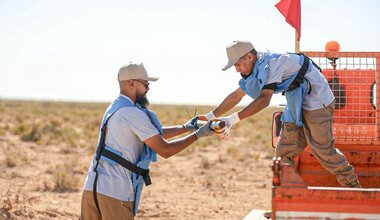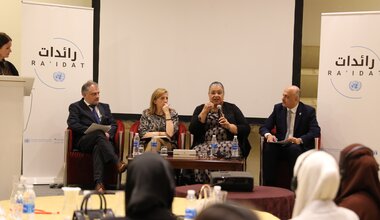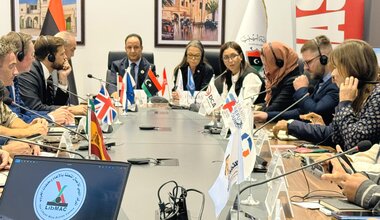Human Rights Report on Civilian Casualties - February 2018
Tunis, 1 March 2018 – From 1 February to 28 February 2018, the United Nations Support Mission in Libya (UNSMIL) documented 146 civilian casualties – 13 deaths and 133 injuries – during the conduct of hostilities across Libya. Victims included nine men, two women, one girl and one boy killed and 119 men, six women, seven boys and one girl injured.
The majority of civilian casualties were caused by Improvised Explosive Devices (IEDs, one death and 116 injuries), followed by gunfire (seven deaths and eight injuries), explosive remnants of war (ERW, two deaths and six injuries), and shelling (three deaths and three injuries).
UNSMIL documented civilian casualties in Benghazi (four killed and 122 injured), Sabha (six deaths and nine injured), Warshafana (two killed and two injured) and al-Zawiya (one killed).
UNSMIL documented seven additional casualties from other violations of international humanitarian law and violations or abuses of international human rights law in al-Zawiya, Benghazi, Derna, Tripoli and Sabha.
Civilian Casualty Incidents
Between 3 and 25 February, clashes in Sabha between Awlad Suleiman and Tabu tribal armed groups claimed at least six civilian lives and nine civilian injuries. The use of indiscriminate fire in densely populated areas led to civilian casualties. Snipers also apparently targeted civilians and civilian vehicles. Civilians came under fire while at home, on the road and even at the hospital. Victims included civilians of Arab, Tabu and Tuareg origins. Civilian casualties included a woman injured in the stomach, reportedly by sniper fire, while travelling in a car with relatives on 3 February. On 4 February, at least two civilian men were killed and another injured when their homes in the Tayouri area were shelled, apparently by mortars. On 16 February, the body of an unidentified woman bearing a gunshot wound to the head was found near the al-Seif roundabout. On 19 February, a 70-year-old man sustained fatal shrapnel wounds to the chest when his home was shelled. Documented incidents also include the injury of a 25-year-old woman and her seven-year-old daughter on 24 February in the shelling the Tayouri area. On 24 February, a woman sustained a minor injury to the leg when a minibus carrying medical personnel to the Sabha Medical Centre came under fire near the area of Qorda. On 24 February, a 15-year-old girl died from injuries sustained earlier that day after the car she was travelling in came under fire near the Sabha Medical Centre. The sources of fire could not be determined, while rivals traded accusations over the use of snipers to target civilian vehicles. On 28 February, a civilian man was shot dead while in his car in the area of Tayouri, while another civilian man was injured by gunfire in the area of al-Nasriya. On the same day, a 12-year-old boy was injured by a stray bullet, while on the rooftop of his house in the area of Qorda.
On 9 February, two IEDs exploded inside the Sa’ad Ben ‘Ubada mosque in the neighbourhood of Majuri in Benghazi, leaving the imam of the mosque dead and another 116 civilians injured, including six boys aged between four and 12.
On 19 February, a woman was shot dead while inside a moving vehicle near the al-Sirti roundabout in Benghazi. At the time of the incident, members of the Special Forces armed group were protesting the removal of their former commander Wanis Bukhamada. They had blocked a number of roads, burned car tires, and shot at the approaching vehicle apparently to prevent it from crossing the road.
On 21 February, Special Deterrence Force (SDF) fighters raided the Sahari Bank in the area of al-Maya in Warshafana with the declared aim of arresting members of a criminal gang involved in armed robbery and kidnappings. According to eyewitness accounts, SDF fighters recklessly fired shots inside the crowded bank leading to casualties. At least two civilians were killed, and another two injured. In relation to the injured, a fighter with the SDF deliberately shot a bank client in the legs on suspicion that he was concealing a weapon. A female client, who was standing nearby, sustained injuries to her face and legs from ricocheting shrapnel.
On 21 February, a 14-year-old boy was killed in the area of Harsha in al-Zawiya in crossfire during clashes between two local armed groups. The boy sustained a fatal gunshot wound to the head.
ERWs and other unknown explosives continued to claim civilian casualties in Benghazi neighbourhoods that have witnessed protracted fighting. Between 6 and 22 February, two men were killed and six injured when explosives detonated in the areas of Wist al-Blad, Sidi Kharabish and al-Masakin.
Civilian Facilities
The Sa’ad Ben ‘Ubada mosque in Benghazi remained closed for about a week for repairs following the IED explosions on 9 February.
In February, the Sabha Medical Centre was hit on two occasions by stay bullets, leading to civilian casualties. In particular, on 6 February, a 60-year-old patient was injured in her hand while in the internal medicine wing. On 12 February, a 35-year-old woman sustained injuries to her legs while at the pediatric wing. Patients and hospital personnel were evacuated from the two wings. Ongoing clashes in the vicinity of the hospital also led to staff shortages, further impacting the already strained health services in the city.
On 22 February, a mosque in the Tayouri area of Sabha was hit, reportedly by mortar fire, causing material damage.
Attribution
The Benghazi Revolutionaries Shura Council and allies are believed to have been responsible for leaving mines and ERWs in areas of Benghazi they controlled prior to their retreat. The SDF is believed to have been responsible for civilian casualties during its raid on the Sahari Bank in al-Maya on 21 February.
No group claimed responsibility for the deadly attack on the Sa’ad Ben ‘Ubada mosque in Benghazi.
UNSMIL was unable to determine with certainty which parties to the conflict had caused the other civilian casualties in February.
Casualties from other violations of international humanitarian law and violations or abuses of human rights
On 18 February, a woman in labour and her unborn child died on their way to the Wehda hospital in Derna, after armed men affiliated with the Libyan National Army (LNA) stationed at the Kirsa checkpoint delayed their passage. Forces allied to the LNA continue to encircle Derna and impose restrictions on the movement of civilians in and out of the city.
On 22 February, a 3-year-old girl was injured by a stray bullet in the area of al-Fateh in Benghazi. The source of fire was not determined, and there were no armed clashes in the vicinity.
On 24 February, two fighters affiliated to the Hnish armed group in al-Zawiya, including a 17-year-old, were captured and reportedly summarily executed by members of a local rival armed group.
On 25 February, the body of an Egyptian migrant worker was found in the area of Qasr Ben Ghashir bearing gunshot wounds.
In February, a Sub-Saharan African rubbish collector died at the Sabha Medical Centre from gunshot wounds sustained on 28 January 2018. He was reportedly ambushed by a group of armed men, who stole his belongings and shot him in the legs.
Note
The figures for civilian casualties set out above only include persons killed or injured in the course of hostilities and who were not directly participating in the hostilities. The figures do not include those casualties that are not a direct result of hostilities, for example executions after capture, torture or abductions, or casualties caused as an indirect consequence of hostilities. The figures are based on information UNSMIL has gathered and cross-checked from a broad range of sources in Libya, including human rights defenders, civil society, current and former officials, employees of local governments, community leaders and members, witnesses, others directly affected and media reports. In order to assess the credibility of information obtained, where possible, UNSMIL reviewed documentary information, including medical records, forensic reports and photographic evidence.
The figures are only those that UNSMIL was able to document in the reporting period. They are not likely to be complete and may change as new information emerges about incidents involving civilian casualties that took place during this period.
Similarly, while UNSMIL has systematically tried to ensure that the cases it documented are based on credible information, further verification would be required to attain a higher standard of proof. Due to the security situation, UNSMIL has not been able to carry out direct site visits to all relevant locations in Libya to obtain information. Fear of reprisals against sources further hamper information gathering.
While not all actions leading to civilian casualties breach international humanitarian law, UNSMIL reminds all parties to the conflict that they are under an obligation to target only military objectives. Direct attacks on civilians as well as indiscriminate attacks – which do not distinguish between civilians and fighters – are prohibited. Attacks that are expected to cause incidental loss of civilian life, injury to civilians and damage to civilian objects excessive to the anticipated concrete and direct military advantage are also prohibited. Such attacks amount to war crimes that can be prosecuted by the International Criminal Court.
In order to ensure greater protection of the civilian population and essential infrastructure, all parties engaged in fighting in Libya must cease the use of mortars and other indirect weapons and imprecise aerial bombardments in civilian-populated areas, and not place fighters or other military objectives in populated areas. All executions of captives must cease and all those captured including fighters must be treated humanely in all circumstances. Murdering or torturing captives is also a war crime, regardless of what the captive may be accused of.
Cases highlighted in the “Casualties from other violations of international humanitarian law and violations or abuses of human rights” section include casualties caused during incidents that would constitute a violation of international humanitarian or human rights law, but are not a direct result of hostilities, for examples executions upon capture of civilians and others hors de combat (such as captured fighters) and torture causing death. The section also includes casualties caused by the proliferation of weapons and impunity enjoyed by armed groups and criminal networks – considered as indirect consequences of hostilities. Cases highlighted in the “other casualties” section are not included in the figures for civilian casualties and include only those that UNSMIL documented during the month.
Contact UNSMIL’s Human Rights Monitoring Team to report information on civilian casualties in Libya at the following email address: unsmil-monitoringhumanrightsteam@dfs.un.org.
 United Nations Peacekeeping
United Nations Peacekeeping UN
UN









